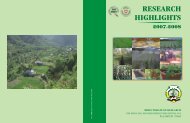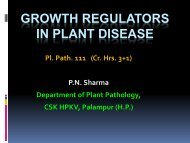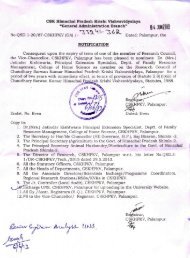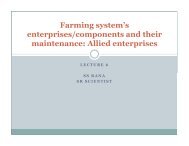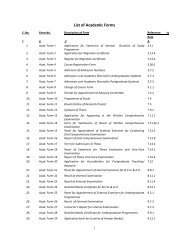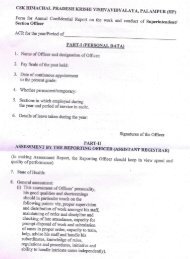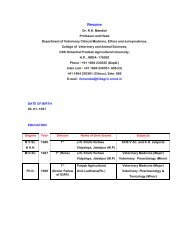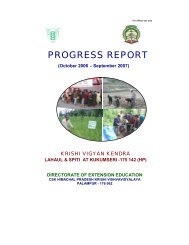animal production - CSK Himachal Pradesh Agricultural University ...
animal production - CSK Himachal Pradesh Agricultural University ...
animal production - CSK Himachal Pradesh Agricultural University ...
Create successful ePaper yourself
Turn your PDF publications into a flip-book with our unique Google optimized e-Paper software.
Vitamins: There are about 15 vitamins needed by <strong>animal</strong>s. However, for dairy <strong>animal</strong>s only vitamin A, D, E and K are<br />
dietary essential. Most of the green fodders are rich in these vitamins. A vitamin mixture is generally fed when green fodder<br />
is not available or is available in limited quantities.<br />
Formulation of economical and balanced rations<br />
The ration of the <strong>animal</strong>s can be divided into two parts i.e. maintenance ration and <strong>production</strong> ration. The maintenance<br />
ration takes care of the body needs of the <strong>animal</strong>, whereas the <strong>production</strong> ration is utilized for the products which<br />
<strong>animal</strong> is to produce. The main product of daily <strong>animal</strong>s is milk. However for growing <strong>animal</strong>s, gain in body weight and for<br />
pregnant cows growth of foetus also come under this category. The maintenance and <strong>production</strong> requirements are added<br />
together before formulation of daily allowance of the <strong>animal</strong>s.<br />
The nutritionists formulate rations for <strong>animal</strong>s keeping into consideration four points namely, maintenance need of<br />
<strong>animal</strong> which depends on body weight, <strong>production</strong> need of <strong>animal</strong> which depends on quantity and quality of the product to<br />
be produced, the availability of the different fodders, feed ingredients as well as by-products and nutrients available from<br />
these fodders and feeds.<br />
The nutrients available from different fodders are given below. Some examples are given for formulation of<br />
economical and balanced rations.<br />
Average nutritive value of common feeds and fodders on fresh weight basis:<br />
Feed Moisture CP DCP TDN MR<br />
Ingredient (water) (%) (%) (%) (Mcal/kg)<br />
(a) Concentrate feeds/by-products<br />
Maize 10 9.0 7.2 82 2950<br />
Barley 10 9.5 8.0 75 2700<br />
Jowar 10 7.2 6.0 70 2520<br />
Bajra 10 6.6 5.5 65 2340<br />
Gram 10 14.4 12.0 80 2880<br />
Wheat 10 12.8 10.5 80 2880<br />
Oats 10 10.4 8.0 75 2700<br />
Wheat bran 10 15.0 12.0 60 2160<br />
Rice bran 10 9.6 5.0 65 2340<br />
Maize husk 10 4.8 4.0 60 2160<br />
Gram husk 10 0.6 0.5 55 1980<br />
Cotton seed 10 14.4 12.0 85 3060<br />
Brewer’s<br />
dried grain 10 18.0 15.0 52 1872<br />
Groundnut cake 45.0 40.0 75 2700<br />
Sarson cake 10 36.0 30.0 74 2664<br />
Cotton seed cake 10 21.6 18.0 70 2520<br />
Til cake 10 45.6 38.0 78 2808<br />
Linseed cake 10 37.2 31.0 65 2340<br />
Maize cake 10 21.6 18.0 74 2664<br />
Toria cake 10 33.6 28.0 68 2448<br />
Triticale 10 14.0 11.0 75 2700<br />
(b) Green fodders<br />
Berseem :<br />
Ist cut 90 1.8 1.5 10 360<br />
2nd cut 85 2.4 2.0 12 432<br />
3rd cut 80 2.6 2.2 15 540<br />
4th cut 78 3.0 2.5 17 612<br />
Jowar:<br />
Young 80 0.9 0.8 11 396<br />
Prime 75 0.6 0.5 16 576<br />
Ripe 70 0.3 0.2 20 720<br />
7



